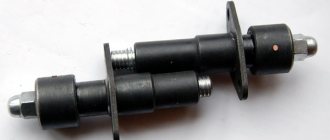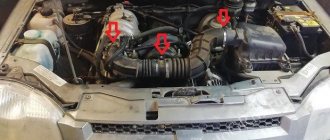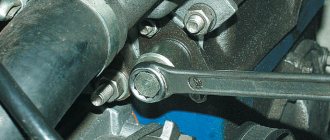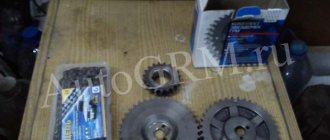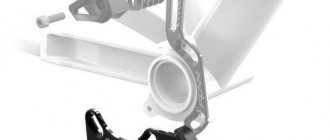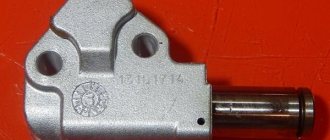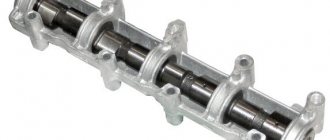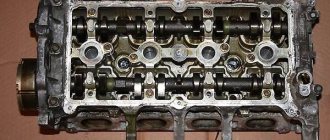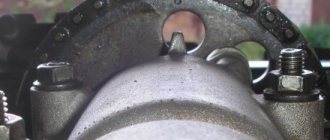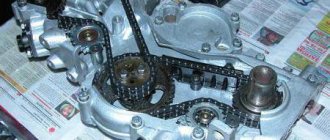The tensioner shoe is a component of the tensioner of the timing chain of piston internal combustion engines; a metal or plastic part that transmits and distributes the load from the tensioner to the timing chain in order to ensure the required degree of tension.
In internal combustion engines, the gas distribution mechanism (GRM) is driven by a belt or chain drive from the crankshaft. For normal operation of the timing drive, it is necessary that the belt or chain have a certain degree of tension, otherwise spontaneous changes in valve timing are possible. In timing chain drives, this problem is solved by a tensioner (or simply a tensioner), the force from which is transmitted to the chain through a special part - a shoe.
The tensioner shoe has three main functions:
- Transfer of forces from the tensioner pusher to the drive chain branch;
- Uniform distribution of force from the tensioner pusher along the chain branch (which ensures a reduction in the intensity of its wear);
- Prevents chain branch vibrations (the shoe acts as a damper).
The tensioner shoe is a critical part for the operation of the entire timing drive, therefore, in case of any breakdowns and exhaustion of its service life, it must be replaced. But before you buy a new part, you should understand the existing types of shoes, their designs and operating features.
Timing chain tension
To tension the VAZ 2106 timing chain you will need:
- set of open-end wrenches;
- flat screwdriver;
- socket wrench 19.
Procedure
The VAZ 2106 timing chain is tensioned as follows.
- Using the above algorithm, the air filter, fitting and tensioner shoe are removed.
- A 19 mm spanner is put on the crankshaft nut.
- Using a wrench, the shaft is turned clockwise until the chain tension under and above the crankshaft is the same. The tension level is checked manually. To fully tension the chain, the crankshaft must make at least two full revolutions.
Video: tensioning the timing chain of a VAZ 2106
Thus, even an inexperienced car enthusiast can replace the fitting and shoe of the VAZ 2106 timing chain tensioner with his own hands. To do this, you will only need a minimum set of plumbing tools and precise adherence to the instructions of specialists.
Purpose of timing chain guide on VAZ 2106
The purpose of the timing chain damper is easy to guess from its name. The purpose of this device is to prevent the timing chain from oscillating too much, since strong vibrations can cause the timing chain to fly off the guide sprockets. The second option is also possible: the chain, having become thoroughly loose without a damper, will simply break.
If the damper does not control the vibrations of the timing chain, the chain will inevitably break.
As a rule, a timing chain break occurs when the crankshaft rotation speed reaches maximum values. In such a situation, the driver simply does not have time to react to the broken circuit and turn off the engine in time. Everything happens instantly. As a result, the valves and pistons of the engine are damaged, and it is not always possible to eliminate such damage.
When the timing chain breaks, the valves are the first to suffer. It is not always possible to restore them
Sometimes things get so bad that it’s easier to buy a new car than to bother with restoring an old one. It is for this reason that the condition of the timing chain damper must be carefully monitored.
Timing chain damper device
The timing chain guide is a metal plate made of high-strength steel. The plate has a pair of mounting eyes with holes for bolts.
The chain guides on the “classic” are always made of high-strength steel and can last for years
Next to the damper is the second part of this system - the tensioner shoe. This is a curved plate that is in direct contact with the timing chain. To prevent premature wear, the surface of the shoe is coated with a wear-resistant polymer material.
The second part of the timing chain calming system is the tensioner shoe. Without it, the chain guide will not work
The chain guide is located on the right side of the engine, under the timing cover, between the crankshaft and timing shaft sprockets. Therefore, to replace the damper, the car owner will have to remove the timing cover and slightly loosen the chain.
Operating principle of the timing chain damper
As soon as the owner of a VAZ 2106 starts the engine of his car, the crankshaft and timing shaft begin to rotate. However, these shafts do not always start rotating at the same time. The shaft sprockets are connected by a timing chain, which over time begins to sag slightly due to natural wear. In addition, the teeth on the shaft sprockets also wear out over time, which only increases sagging.
Due to wear on the teeth on the timing sprocket, the chain sags more and may eventually break.
As a result, a situation arises when the crankshaft has already turned a quarter of a turn, and the timing shaft has just begun to rotate. In such a situation, the timing chain slack increases sharply, and to eliminate this slack, a hydraulic tensioner is activated.
On one side there is a tensioner shoe, and on the other there is a damper, which is the second part of the damping system
Its shoe is screwed to the oil fitting, which, in turn, is connected to the oil line with an oil pressure sensor. As soon as the chain sags, the sensor detects a sharp decrease in oil pressure in the line, after which an additional portion of lubricant is supplied to the line. Under its pressure, the tension shoe extends and presses on the timing chain, thereby compensating for the resulting sagging.
All this happens very abruptly, and as a result, the timing chain begins to vibrate strongly, and not on the side of the tension shoe (where the chain is securely pressed), but on the opposite side. To dampen these vibrations, another device is used - a timing chain damper. Unlike the tensioner shoe, the damper has no moving parts. Essentially, this is a high-strength steel plate against which the timing chain hits after it is pressed down by the tension shoe. But if there is no damper in this system, the shaft teeth and timing chain will wear out much faster, which will inevitably lead to complete engine failure.
What do users recommend?
Car enthusiasts give different advice on how to improve or select a chain tensioner. Mercedes and other foreign cars from well-known manufacturers are often equipped with a timing chain drive. As a rule, the device for tensioning the chain in modern cars is designed to be automatically adjusted. This makes it easier to maintain and repair the unit, ensuring its reliable operation.
In addition, when replacing the tensioner, users recommend setting the rod of the new device to the minimum position. This makes it possible to pump the working chamber as much as possible, avoiding jamming and unnecessary noise. This, in turn, contributes to the correct adjustment of the degree of chain tension.
Timing belt with chain drive on VAZ 2101
The “kopek”, like all other “classic” models, has a timing chain drive. The mechanism consists of a double-row metal chain and additional elements that ensure its tension and prevent vibrations. The well-coordinated operation of the motor directly depends on the integrity and serviceability of each part of the mechanism. The chain drive connects the crankshaft and camshaft and ensures their synchronous operation. When the shafts rotate, the pistons in the engine cylinders are set in motion, and the valves in the cylinder head (cylinder head) open and close in a timely manner.
The main elements of the VAZ 2101 timing drive are a chain, a damper, a shoe, a tensioner and sprockets
Tranquilizer
The damper performs the function of damping circuit vibrations. Without it, the chain may jump or fly off the sprockets of the timing mechanism. If the damper breaks down, the drive may simply break off. Such a nuisance is possible at high engine speeds. If the chain breaks, the pistons and valves are damaged, requiring expensive repairs. Therefore, the condition of the damper must be monitored and replaced in a timely manner. The part is a durable metal plate with special holes for fastening.
The chain damper dampens its vibrations when the engine is running.
Opposite the damper there is a shoe, which is also responsible for calming and tensioning the chain. It is made of a special polymer material, which gives the part high wear resistance.
The tensioner shoe is responsible for tensioning the chain and damping vibrations together with the damper
Tensioner
The “penny” chain drive tensioner prevents the chain from loosening when the motor is running. The element comes in several types:
- auto;
- mechanical;
- hydraulic.
Automatic tensioners began to be produced recently, but with regard to this part, it is already possible to note the pros and cons. The main positive point is that there is no need to make periodic adjustments, i.e. the drive is constantly in tension. The disadvantages include fairly quick failure and high cost of the part. In addition, based on reviews from car enthusiasts, the auto tensioner does not tension the chain very well.
The operation of hydraulic devices is based on the supply of oil under pressure from the engine lubrication system. With this design, the driver does not need to worry about periodically tightening the chain. However, over time, the part may malfunction, which manifests itself in the form of jamming of the mechanism.
The VAZ classic uses a mechanical tensioner. The part has a significant drawback: over time, it becomes clogged with small particles, the plunger jams and the device loses its ability to produce tension.
The chain tensioner is designed to keep the chain taut at all times.
One of the key elements of the timing chain drive is the chain itself, made of metal and having a certain number of links: on the VAZ 2101 there are 114 of them. Compared to a belt drive, the chain is more reliable and has a longer service life.
The chain is considered a more reliable element compared to the belt
Depending on the quality of the chain and the operating conditions of the vehicle, it is replaced every 60–100 thousand km. There are cases that a part lasts for 200 thousand km, but it’s hardly worth the risk, because a broken chain will result in a much more expensive repair than its timely replacement.
The chain is tightened every 10 thousand km, even in the absence of signs indicating sagging.
Gear shoe for chain tensioner VAZ 2101 2107
Replacing the chain tensioner on a VAZ 2107 does not present any difficulties; it can be removed and installed in literally a matter of minutes.
Replacement
How to replace the timing chain tensioner
Removal: 1) First, remove the two nuts that secure the chain tensioner to the engine.
Unscrewing the chain tensioner fastening nut
2) Then remove the chain tensioner from the car engine.
Note! There is a sealing gasket between the chain tensioner and the engine, remove it carefully, do not damage it! (For information on what a sealing gasket looks like, see the very bottom of the article, in the “For Beginners!” section)
Installation: 1) First, charge the new chain tensioner. (For information on how to charge the chain tensioner, see the article “How to charge the chain tensioner on a VAZ?”)
2) Then reinstall it in the reverse order of removal.
3) Now turn the crankshaft clockwise in order to tension the timing chain. (For information on how to turn the crankshaft, see the article “Installing the piston of the fourth cylinder to the TDC position”, in paragraphs “1-2”)
Note! In the article to which the link is given in paragraph “3”, by clicking on it you will also need to set marks, but if you are replacing only the chain tensioner, then you do not need to set any marks, just turn the crankshaft “1-1.5” turns and that’s it !
4) After you have completed cranking the crankshaft, loosen the cap nut slightly to allow the tensioner to discharge.
Note! When the chain tensioner is discharged, you will hear a click and only then tighten the chain tensioner nut back!
How to change a shoe
You will need: “10”, “13”, “17” wrenches, a special wrench for the crankshaft pulley nut (or a “36” socket), a flat-blade screwdriver, a mounting blade, a hammer, and a bit.
1. Remove the engine splash guard.
2. Remove the generator drive belt (see “Checking and adjusting the tension of the generator and water pump drive belt and replacing it”).
3. Remove the engine cooling fan with the electric motor and casing assembly.
4. Unscrew the three bolts 2 securing the oil sump to the camshaft drive cover and loosen (by unscrewing 2-3 turns) the two bolts 1 securing the oil sump to the engine crankcase.
5. Remove six bolts 1 and three nuts 2 securing the camshaft drive cover.
6. Unscrew the crankshaft pulley securing nut and remove it.
7. Use a mounting blade to pry the pulley and remove it from the crankshaft.
8. Using a screwdriver, carefully pry off the camshaft drive cover and its gasket.
9. This is where tensioner shoe 1 and tensioner bolt 2 are located.
10. Remove the bolt securing the tensioner shoe and remove the shoe.
11. Install the new tensioner shoe and the removed parts in the reverse order of removal. When purchasing a new shoe, pay attention to the markings (shown by the arrow); purchase a shoe with exactly the same markings.
12. After final assembly, adjust the chain tension.
13. Install the removed parts in the reverse order of removal. Adjust the tension of the generator drive belt (see “Checking and adjusting the tension of the generator and water pump drive belt and replacing it”).
How to charge
How to charge a mechanical chain tensioner on a VAZ?
1. This is all done very simply, first remove it from your car (For information on how to remove the tensioner, read the article: “Replacing the chain tensioner on a car”), during removal, by the way, the central nut may be removed (If you have not used the tensioner for quite some time) removed) you have rusted and with the tensioner removed, you may not even be able to unscrew it, so with the tensioner installed, namely when you remove it, remove the central nut with a wrench (there will be a small click, you should hear it) and only after that unscrew the two nuts that secure it and then remove the chain tensioner itself.
2. Now, when you have the tensioner in your hands, either loosen its central nut as shown in the photo below (This is if you did not loosen it when removing the tensioner), or immediately proceed to loading the tensioner, the tensioner is charged only after the plunger is loaded will come out completely (the plunger is indicated by the arrow, and it comes out after loosening that same central nut), if it has already come out, then you need to insert it back with force, to do this, press the tensioner with both hands as shown in the small photo, the plunger into this While you press on the tensioner, it will not sink much and when you feel that it is no longer drowned and has reached its limit, hold the tensioner in this position and tighten its central nut until it stops, thereby the plunger will lock and the tensioner will be charged.
Adjustment
To adjust the chain tension, you need a spanner for the chain tensioner nut and a special wrench to turn the engine crankshaft. The latter can be replaced with a 36 ring wrench.
Adjusting the tension begins by loosening the chain tensioner nut. In this case, if the chain has been loosened, the tensioner shoe should move slightly and tighten it.
If the shoe is stationary and the chain is not tensioned, release the tensioner plunger by lightly tapping the nut with a hammer. Sometimes it doesn't help. Then you should remove the tensioner and restore its functionality or replace the part. This malfunction (plunger jamming) is quite typical for VAZ engine chain tensioners. This is why it is advisable to remove the engine head cover and check the chain tension, rather than adjust it “blindly”.
To properly tension the VAZ 2107 chain, you need to turn the engine crankshaft with a special wrench clockwise 1-1.5 turns, stopping it at the moment when the rotation resistance is maximum.
Important: some mechanics prefer to turn the crankshaft with the starter when adjusting the chain tension. This is not recommended, since the correct tension can only be achieved by smoothly rotating the crankshaft and stopping at the moment of greatest resistance to rotation.
After completing the operation, all that remains is to firmly tighten the tensioner cap nut and replace the engine head cover.
Types and design of tensioner shoes
On VAZ-2101, 2103, 21213/21214 engines of all modifications, sliding tensioner shoes are used - the chain slides along their surface, which has an anti-friction coating. Today you can find two types of shoes, differing in materials of manufacture:
- Old-style shoes - metal with anti-friction coating; — The new type of shoes are solid plastic.
The old style tensioner shoes have an extremely simple design. The basis of the part is a bent steel plate, at one end of which there is a loop for mounting on the engine. On the outer (convex) side, a layer of plastic is applied to the plate, with which the shoe slides along the chain. On the inside, closer to the end of the shoe, a bracket is attached with the help of two rivets - a stop for the tensioner.
The new style shoe is a one-piece plastic part that has an arched shape with a molded bracket for the tensioner stop and a loop for mounting on the engine. To increase strength and reliability, stiffening ribs are made in the body of the shoe.
According to their applicability, tensioner shoes are divided into several groups:
— Shoe type 2101-1006090 — used on VAZ 1200 and 1300 engines. A distinctive detail of this shoe is a semicircular recess in the upper part of the bracket (pusher stop); — Shoe type 2103-1006090 — used on VAZ 1500 and 1600 engines. A distinctive detail of this type of shoe is a semicircular recess in the lower part of the bracket (from the hinge side); — Shoe type 21213-1006090 — used on the VAZ-21213 (1700) engine. It has no marks and is larger in size; — Shoe type 21214-1006090 is a modern plastic shoe used on VAZ-21214 and some other 1700 engines.
There was also a universal tensioner shoe available in the 1970s, but it is impossible to find today.
The tensioner shoe is installed under the timing cover; it is mounted on the engine using one complexly shaped bolt, which also acts as an axle. Such a bolt ensures reliable installation of the shoe, but at the same time prevents excessive tightening and jamming of the part during operation.
Why is the device replaced?
With prolonged use, the VAZ 2107 chain tensioner weakens (the spring loses its elasticity), which leads to improper operation of the device. This has a negative impact on the operation of the engine, since the valve timing gradually shifts, which contributes to increased heating and wear of the cylinder-piston group parts.
If it is no longer possible to tension the chain, then it may be time to replace the chain itself or one or both shoes, but perhaps only the VAZ 2107 chain tensioner has become unusable and you can only get by by replacing it, without expensive repairs. In the material we will consider the question of how to replace the chain tensioner on a VAZ 2107 car without affecting the tensioner shoe.
What is required for the work
To replace the tensioner on a VAZ 2107, you will need to use simple tools:
- Open-end wrenches for “10” and “13”.
- Key for turning the crankshaft.
After making sure that the above tools are available, you can begin work.
How much does a new product cost?
For the VAZ 2107, a tensioner from classic VAZ models is suitable, so you can choose any one that is available on the market. The average cost of this device is 600-700 rubles. Experienced drivers recommend giving preference to devices from the Tolyatti Automobile Plant, which are supplied in blue packaging. The package contains the packer's number, as well as a special sticker with a code underneath. If you send this code to the number, you will receive an SMS message with confirmation.
It is important to know! Purchase products only from certified stores to avoid purchasing counterfeits.
The Pilot brand device is also receiving positive reviews. It has its advantages compared to the standard one, and at the same time it is considered maintenance-free and more reliable. Below is the packaging of the ANC “Pilot”.
Once the Pilot or standard chain tensioner has been purchased, you can proceed to the replacement procedure. The advantage of the “Pilot” is the fact that it is an automatic chain tensioner for the VAZ 2107, which independently regulates and maintains the degree of chain tension on the seven.
Product replacement principle
To replace a worn chain tensioner on a VAZ 2107 with a new one, you will need to perform the following steps:
- The battery is removed from the car to provide access to the element being removed.
- The device is located on the right side of the front of the engine. Using a “10” wrench, you need to unscrew the 2 nuts securing the device.
- In the next step, we remove the device from the engine with our hands.
- We take a new tensioner, loosen the cover nut with a wrench to “13”, then press the protruding plunger into the tensioner itself until it stops, and tighten the same nut. To make this procedure easier, you can use a vice. This must be done to facilitate installation of the device into the engine.
- Once the device is installed, it can be installed in place, not forgetting about the gasket. We fasten the product using fastening nuts. The device is discharged; to do this, release the cap nut. At the same time, the plunger will become free and shoot, thereby causing a tight fit of the shoe to the chain.
- Using a 36-38 wrench or a pipe wrench, you need to turn the crankshaft clockwise 1.5-2 turns. At the moment of greatest resistance during rotation, we stop. It is important to ensure that the crankshaft remains in this position and does not move a millimeter against the stroke, otherwise the chain will sag.
- After this, you will need to tighten the cap nut tightly to “13”.
- Finally, start the engine and listen.
Repair of the tensioner on Lada cars is usually not carried out, so if it stops tensioning, it needs to be replaced. You can see the process of replacing the device in question in more detail in the video above.
In order to change an automatic tensioner, on average you need 600-700 rubles. TZA (Togliatti Automotive Units Plant) produces the best, “native” tensioners for “classics”. The package (blue) has the packer's number as well as an authentication sticker with a protective layer. Under the layer there is a code, when entered, you will receive an SMS confirmation. Inside there must be an insert - a form with the name of the product, the date of manufacture, and the blue original seals of the quality control department.
First, remove the cylinder head cover. This will be required in order to correctly determine the chain tension at the very end.
- Remove the air filter housing from the carburetor. Then we disconnect the throttle linkage from the roller.
- Then you need to remove the lever with rods.
- And finally, we disconnect the fuel hose from the bracket that goes from the fuel pump to the carburetor.
- Using a 10 mm tubular wrench, remove the cylinder head cover. This must be done so that you can check the chain tension by hand.
- The VAZ 2107 timing chain tensioner is located on the right front side of the engine. First, using a 10mm wrench, unscrew the tensioner mounting nuts.
- We take it out of the engine. There should be a gasket between the engine housing and the tensioner. Try not to damage or lose it, since a new gasket is almost always sold only complete with the tensioner. Sometimes it can start to “etch”, and in order not to purchase a kit to replace it, save the old gasket.
- We fix the new automatic tensioner vertically in a bench vice. Then use a 13 mm wrench to loosen the cap nut. After this, the plunger became movable and moves freely in the tensioner body.
- Now we “charge” the tensioner plunger. To do this, we place it vertically (the place where we place it is shown by a blue triangle). Then press vertically downwards with force (pressure points are shown in red). The plunger is “recessed” into the body.
- Now you need to continue pressing on the body and holding the plunger “cocked” and tighten the nut back with a 13 mm open-end wrench.
- Now we install the “cocked tensioner” together with the gasket into the engine housing. Using an open-end wrench 36-38 (the VAZ 2107 may have either a nut or a ratchet, so the sizes are different), turn the crankshaft clockwise by an average of one and a half to two turns. When the greatest resistance to movement arises, then the chain will be stretched to its maximum. The main thing is to ensure that the crankshaft does not turn back due to compression and that the chain tension does not weaken. If you don’t have a key for 38, you can turn on the ignition and turn the crankshaft with the starter.
- We tighten the nut back, holding the crankshaft from “shock absorption” back. Then we check the tension result by pressing the chain with our hand again. There should be no deflection. Now we install the block head cover in place.
- Only after the chain is tensioned should you loosen the tensioner cap nut. The plunger will release and "shoot", causing the shoe to seal tightly against the chain. At this time, a click will be heard. Only after a click does the tensioner cap nut need to be tightened tightly.
We check and change the timing chain on a VAZ 2106
Why do you need a timing chain and its characteristics?
Old VAZ 2106 models were equipped with a mechanical plunger tensioner, in which the rod is pushed out by a spring. In new modifications, hydraulic plungers are installed; they operate due to oil pressure. The chain must always be tensioned for correct engine operation.
Tension is carried out using a semicircular shoe, which supports the element on the left. The damper plate is also adjacent to the chain. A metal stop located on the cylinder block prevents the chain from jumping off the lower sprocket in the event of significant stretching. When the drive elements rotate, the shoe and damper press on the chain from different sides.
The timing chain drive in the VAZ 2106 power unit performs the following functions:
- transmits torque from the crankshaft to the camshaft, which regulates the position of the intake and exhaust valves of the cylinder head;
- rotates the distributor shaft;
- The gear in the middle ensures the operation of the oil pump.
The number of links depends on the type of engine installed. The sixth models were equipped with power units of 1.3, 1.4 and 1.6. The piston stroke length for motors of the 1st type is 66 mm, for the other two – 80 mm. Depending on the volume of the power unit, a chain of a certain size is taken:
- 1.3 l – 114 links;
- 1.5 and 1.6 – 116 links.
When purchasing a chain, it is easy to check the number of links without having to count them. Straighten the product lengthwise so that the halves fit snugly against each other. If the ends lie the same way, then the number of links is 116; in a short chain, the outermost link will be rotated at a certain angle.
Determining the need to replace the chain
The service life of the timing chain is quite long and is about 100 thousand kilometers. Over time, as the machine is used, the chain gradually stretches. In this case, the metal links are not deformed, their hinges are erased, play appears, and gaps are formed. For a small area, this development is invisible, but if you take the chain drive as a whole, the length of the part will increase significantly.
The degree of wear of the chain drive is determined by the following symptoms:
- Extraneous sounds are heard from under the valve covers. If the chain is too stretched, a loud rattling noise is heard.
- After dismantling the valve cover, check that the protrusion on the crankshaft pulley matches the mark on the camshaft gear.
If there is a displacement of at least 1 cm, this indicates chain stretching.
- After tensioning the chain, start the engine and set new marks. If the extension is significant, these actions will not lead to the desired result; the plunger device cannot remove the slack.
- After removing the valve cover, check the technical condition of the damper. There are times when a chain that is too stretched breaks the lining or tears off the entire element completely. If the damper is broken, the chain rubs against the cylinder head housing and a groove is formed in it.
A chain that has stretched more than 10 mm may jump over several links along the gears. Jumping over one section is fraught with a violation of the valve timing. In this case, the engine vibrates in any operating mode, often stalls, and its power drops significantly. Signs appear in the form of shots in the exhaust pipe or carburetor. Adjusting the ignition and fuel supply does not help eliminate vibration.
Symptoms of loose chain tension
In principle, the symptoms are quite specific, and it is very, very difficult to confuse them with something else.
- Increased engine noise, even at idle speed;
- Instant increase in noise during a sharp increase in speed;
- The roar increases proportionally with a smooth increase in speed, and decreases gradually with a sharp release of the gas pedal;
- Most often, a loose VAZ 2107 chain rattles because the damper has broken and needs to be replaced.
However, let’s say that this is not the case, and we just need some tension. To work, we will need a special key to turn the crankshaft; on carburetor cars, you can turn it using a ratchet.
How to tension a chain on a VAZ 2101 engine
Welcome! Sometimes adjusting the chain tension of “Gas Distribution Mechanisms” is currently an integral part of cars of the “classic” family.
The chain, or rather its tension, is adjusted using two things: using the crankshaft bolt, and also using the chain tensioner. When the chain on a car becomes loose, a characteristic knocking sound appears in the area where the chain is located, which is very clearly audible at idle. Note! To adjust, you will need the following tools: firstly, a spanner wrench will be useful, and secondly, you will need a special wrench for turning the crankshaft bolt. (If you don’t have a special key, then in this case you can use the “36” head)
When do you need to adjust the chain on a VAZ 2101-VAZ 2107? 1) If the chain is loose and dangling. 2) If, when you press the gas pedal sharply or when you release it, a rattling noise occurs in the engine.
